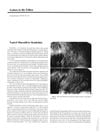TLDR Minoxidil 2% effectively treats Monilethrix without side effects.
This study reports on the treatment of four patients with Monilethrix, a rare hair disorder, using topical minoxidil 2% for one year. The treatment led to an increase in normal hair shaft without any side effects in all patients, suggesting that topical minoxidil 2% could be considered a good therapy to treat Monilethrix. The study also provides clinical observations and videodermatoscopic and ultrastructural features of Monilethrix, as well as a discussion on the etiopathogenesis of the disorder and the action mechanism of minoxidil. The authors suggest that topical minoxidil could be a good alternative to stabilize and support the disease without having any side effects.
21 citations
,
March 2003 in “Clinical and Experimental Dermatology” Mutations in the hHb6 gene cause the hair disorder monilethrix.
32 citations
,
January 2000 in “Human Heredity” Monilethrix severity varies and may be influenced by other genetic or environmental factors.
29 citations
,
August 1999 in “Journal of Investigative Dermatology” 26 citations
,
October 1998 in “Experimental Dermatology” A keratin hHb6 mutation causes a hair disorder with varying severity, influenced by other factors.
100 citations
,
November 1997 in “Human Genetics” A new mutation in the hHb1 keratin gene is linked to the hair disorder monilethrix.
 13 citations
,
January 1991 in “Dermatology”
13 citations
,
January 1991 in “Dermatology” Minoxidil helps hair growth in people with monilethrix without side effects.
34 citations
,
December 1984 in “Journal of Cutaneous Pathology” Monilethrix hair issues are due to problems in the hair's internodes.
 3 citations
,
January 2018
3 citations
,
January 2018 A woman had an unusual allergic reaction to a hair loss treatment, which cleared up after stopping the treatment and using a different medication.
January 2014 in “DOAJ (DOAJ: Directory of Open Access Journals)” Minoxidil can effectively treat patchy hair loss by stimulating hair growth.
April 1985 in “Plastic & Reconstructive Surgery” Topical minoxidil can help regrow hair in alopecia areata but is less effective for severe cases.
 16 citations
,
April 1984 in “Archives of Dermatology”
16 citations
,
April 1984 in “Archives of Dermatology” Topical minoxidil can help hair regrowth in alopecia areata patients, but maintaining the growth after stopping treatment is inconsistent.



